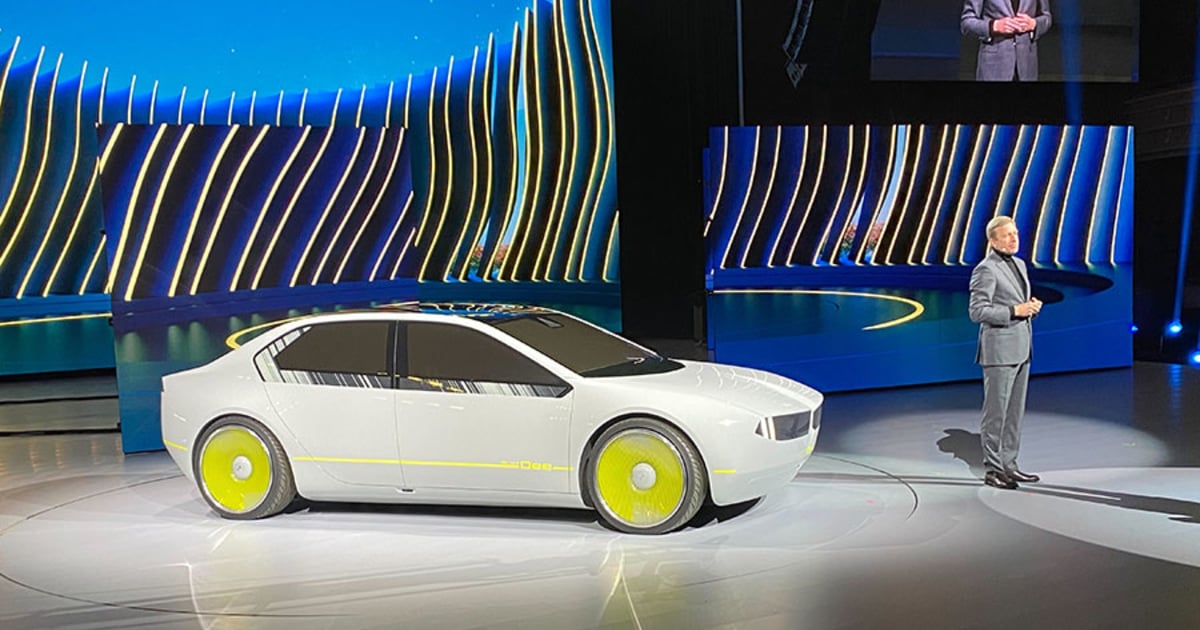
LAS VEGAS — BMW’s new vision of a digital world on wheels, the BMW i Vision Dee midsize sedan concept presented at CES 2023, reveals a smörgåsbord of technologies the German automaker is cooking up to blend virtual and physical experiences.
“With the BMW i Vision Dee, we are showcasing what is possible when hardware and software merge,” BMW Group CEO Oliver Zipse said at a keynote Wednesday. “We are able to exploit the full potential of digitalization to transform the car into an intelligent companion.”
BMW brand design boss Domagoj Dukec said the Dee offers a peek at the digitalization technologies that can make driving safer and more entertaining.
The concept hints at design elements that “show where we want to transform BMW,” Dukec said at a media briefing in Munich last month.
The marque technology in Dee (Digital Emotional Experience) is a head-up display that projects information across the vehicle’s windshield.
Current head-up displays project a small field of view. Expanding the field of view can create a more immersive experience for both driver and passengers.
“With our technology, everyone in the car can see the same information, even the people in the back,” Dukec said.
Using a “Mixed Reality Sider” on the dashboard, the driver can adjust content displayed on the windshield, including driving-related information, infotainment, augmented reality and virtual reality.
The slider “can turn from a physical world to a digital one,” Dukec said.
BMW said the technology will be available in production cars on its next-generation Neue Klasse platform that arrives mid-decade.
Several automakers are exploring super-size infotainment displays, first popularized a decade ago by Tesla in the Model S sedan.
At CES 2021, Mercedes-Benz’s debuted its 56-inch Hyperscreen dashboard display.
Meanwhile, Volvo Cars has invested in Israeli startup Spectralics, which has developed a mixed-reality head-up display technology.
Stephan Durach, BMW Group’s senior vice president of its connected company development unit, said technology should be an enabler, not a distraction.
“When integrating technology in the car, we think about the customer experience it creates and the problem we want to solve,” Durach said at the Munich media briefing. “We want to deliver the information you need at the right time to give you the perfect experience. That’s what people are asking for.”
Using the windshield, rather than a dashboard-based instrument cluster or center display, delivers critical driving information in the driver’s natural line of sight, allowing them to keep their eyes on the road.
“We are opening up a new canvas to distribute the information in an even more meaningful way,” Durach said.
The windshield display also eliminates the need for dashboard-based screens, enabling a minimalist interior.
“We are taking away everything that is not necessary,” Dukec said. “Customers want less complexity.”
BMW said that eliminating the instrument cluster allowed it to design an ergonomic vertical spoke steering wheel.
Surfaces at thumb height to the left and right of the steering wheel come to life when touched and serve to control the content on the windscreen.
Dukec draws parallels to Apple’s iPhone to explain BMW’s less-is-more design aesthetic.
“An iPhone has no button, and you think at first ‘how do I use it?’ ” the designer said. “But then you find out it can do much more than if it had 20 buttons.”
BMW’s philosophy is to use technology to enhance the driving experience. The concept’s interior features touch-sensitive window and seat controls that stay concealed until needed.
“The technology is only visible if you need it,” Dukec said.
The Dee takes vehicle personalization to a new level with a chameleon-like color-changing technology.
The vehicle features a multicolored, configurable exterior that uses E Ink technology to display up to 32 colors on the fly.
The exterior surface is divided into 240 E Ink segments controlled individually, allowing an array of patterns to generate within seconds.
The color-changing technology used in e-readers adds a new twist to BMW’s iconic twin circular headlights, kidney grille and the Hofmeister kink with digital icons.
Elsewhere, sensors enable the vehicle to register the driver’s identity, create a digital avatar and program a greeting scenario that combines graphical elements, sound and light.
And, an advanced voice assistant system uses natural language processing to deliver human-like interaction between man and machine.
While Dee is more of a technology showcase than a road-ready sedan, Durach said the concept is not fantasy.
“It’s a vision aimed at stretching the imagination,” he said. “We’re not showing something which is not feasible.”